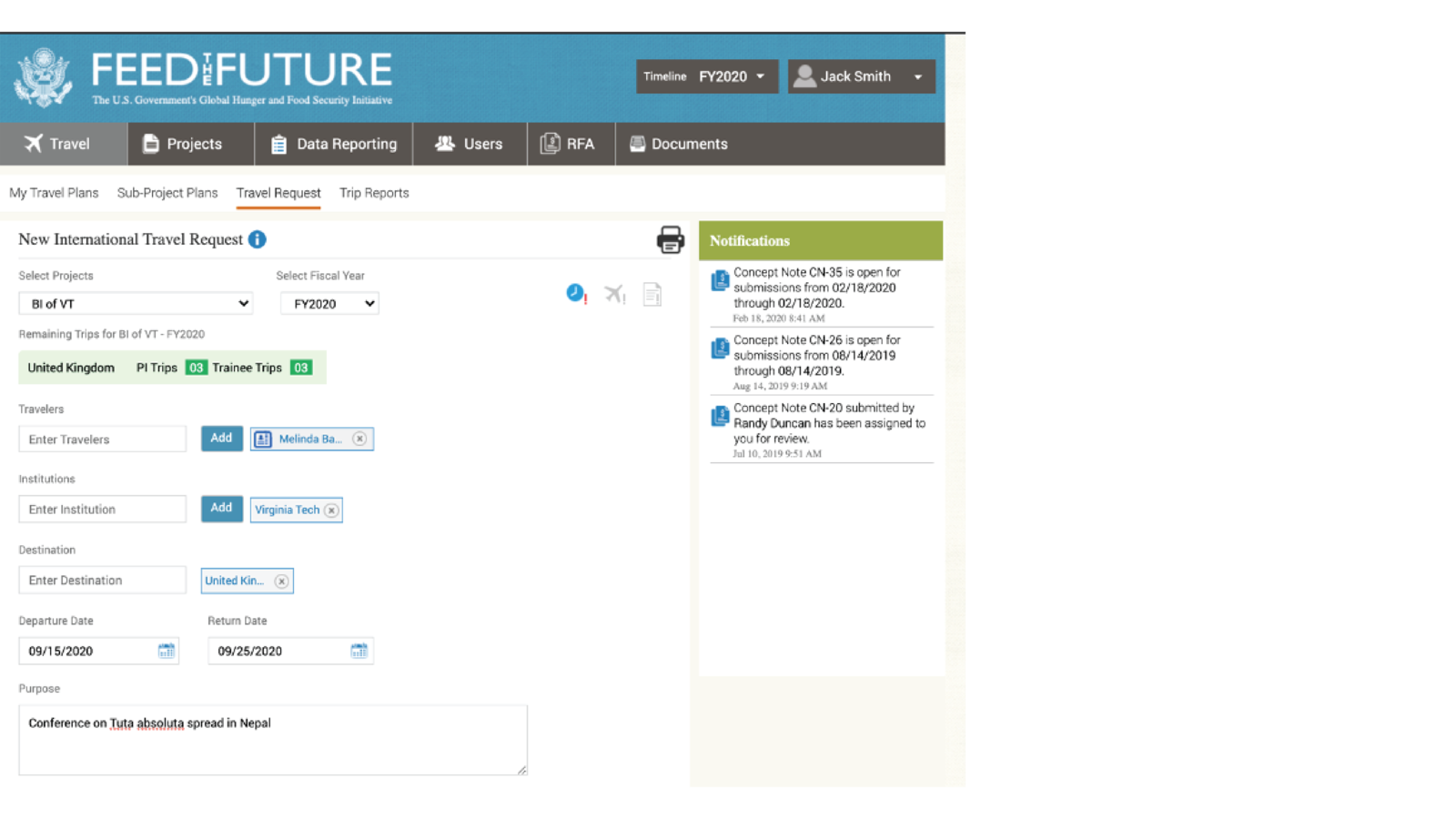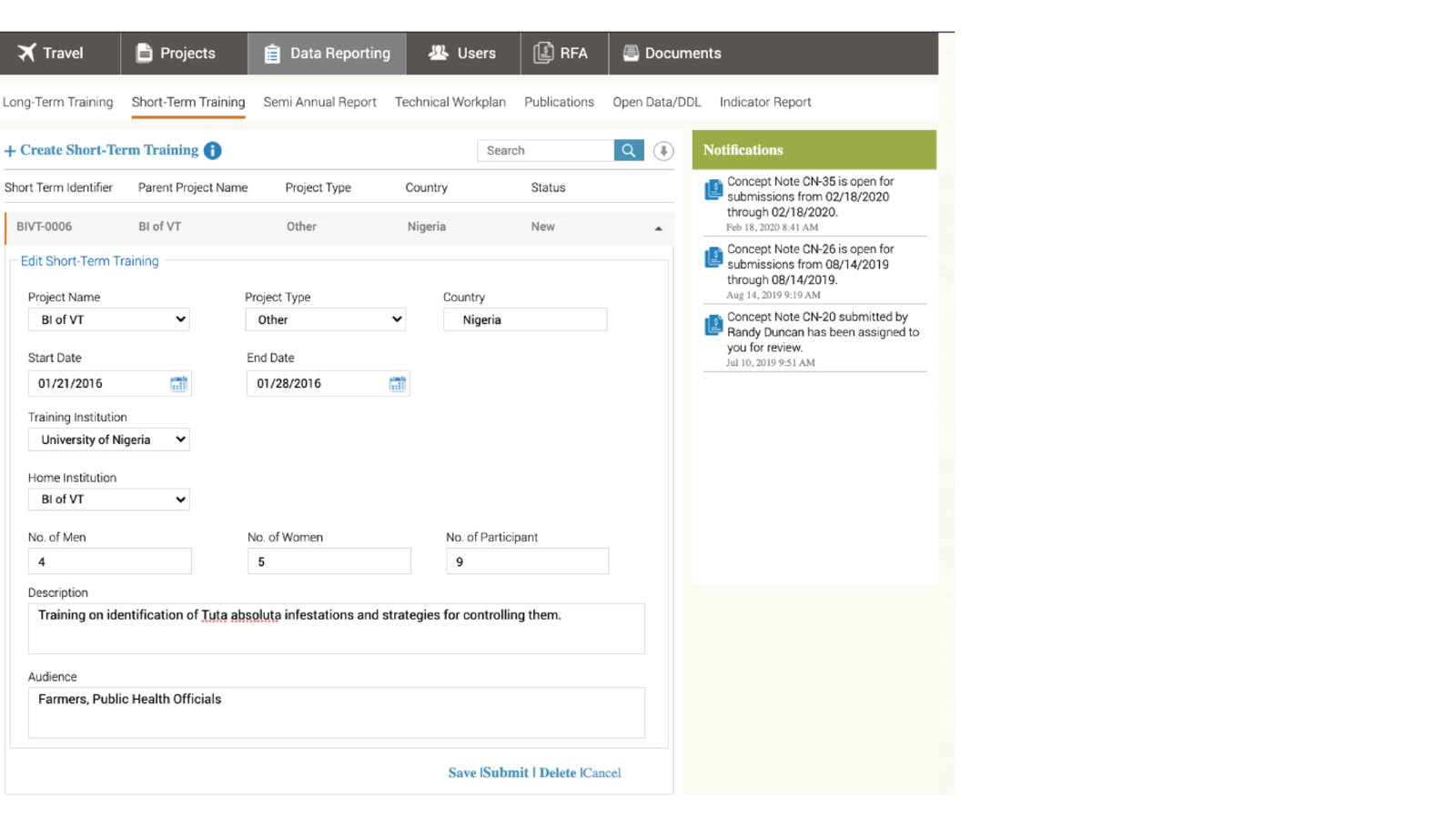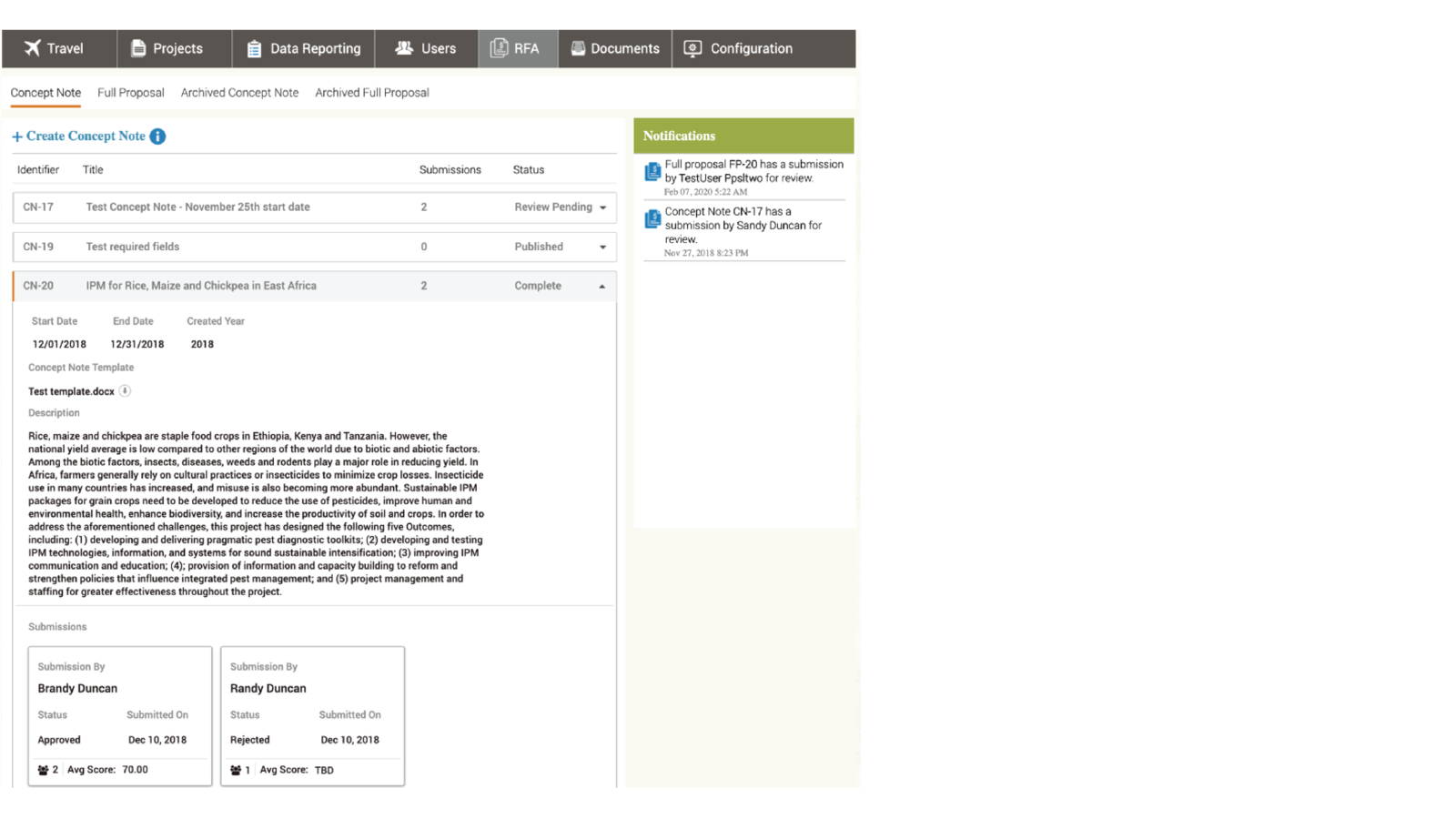USAID has stringent reporting and management requirements that are difficult to track without a dedicated tool. For example, USAID requires that Innovation Labs:
- Develop a travel matrix of planned trips for the coming fiscal year, then ensure that appropriate reporting is submitted;
- Conduct appropriate periodic reporting, including semi-annual reporting, technical workplans, and indicator reports;
- Document training offered to farmers to help reduce infestations and corresponding crop loss;
- Track publications submitted under this award;
- Submit datasets collated from their research to an open digital library so other researchers can build on their work.
We have created the IPM Portal, a web-based project management system tailored to the specific needs of Feed the Future Innovation Labs. In addition to the features described above, it includes an RFA module to help IPM grant subawards to other institutions. The web interface facilitates management of offsite field work.
Integrated Pest Management has been using the IPM Portal to manage their USAID Feed the Future Award since summer 2015. It is made up of several modules, each targeting a different area of award management.
The Travel module allows project managers (subawardees) to be proactive in planning their travel for the upcoming fiscal year, and the IPM administrators to approve or reject such requests. It is made up of the following components:
- A Travel Plan interface where project managers (subawardees) can submit travel plans for the coming fiscal year for each project. Because this can include trips that are early in the planning stages, project managers enter rough details about planned travel, including the countries they plan to travel to, the number of travelers, how many of the travelers are trainees (vs. research staff), and justification for the requested travel.
- A Travel Matrix interface to allow administrators at IPM to collate the submitted travel plans into a travel matrix that can be submitted to USAID for approval. Administrators also have the ability to make changes to the travel matrix as additional travel is requested and approved by USAID.
- A Travel Request form (Figure 1) that allows project managers to submit requests for travel as restricted by the travel matrix; for example, project managers are constrained by the travel plans submitted at the beginning of the fiscal year and receive warnings if they request travel to other countries or extra travelers. Administrators, in turn, can either approve or reject these travel requests.
- A Trip Report tool where users can submit their post-travel trip reports. Users also receive notifications from the system when their trip reports are overdue.
The IPM Feed the Future award is subdivided into smaller awards called “Projects”, many of which are allocated to outside universities. The Project module allows project managers to maintain information about their specific project, as well as the ability to add subprojects beneath their top-level projects. Administrators can use this module to maintain the entire hierarchy of subawards.
The Data Reporting module allows project managers and administrators to report on project-related activities. The categories of Data Reporting that project managers can record and submit include the following:
- Long-term training, which includes students enrolled in a degree program or travelling abroad under the USAID mission
- Short-term training (Figure 2), which are typically presentations to groups of people, such as conferences, seminars, or specialized training
- Semi-annual Reports: These are status updates that are submitted twice a year by project managers for each of their projects; when IPM administrators are satisfied with their reports, they aggregate these project manager reports and other data reporting into a larger status report that is submitted to USAID.
- Technical Workplan: The technical workplan is submitted during the summer to outline what tasks are planned for the coming fiscal year. As with the semiannual report, the IPM administrators combine project-level technical workplans into a larger workplan for submission to USAID.
- Publications, which allows users to document what articles they have submitted for publication or conference talks they have given.
- Open Data/DDL: USAID requires users to submit the data they collect along with any analysis performed on it so other researchers can build on work done by their peers. This data is stored in a common repository open to all of the USAID Innovation Labs. When this project was speced, it was intended that users would be able to submit actual datasets through this interface, but USAID did not have a web service for direct submission of data. This tool allows project managers to submit dataset candidates to the IPM administrators for submission approval, but posting it to USAID’s Open Data/DDL is still a separate, manual process.
- Indicator Report: USAID distributed a list of SPS Indicator questions that they wanted their Innovation Labs to respond to; the Indicator Report module allows administrators to post those questions to the project managers, defining restrictions on answer types (ie, integers or a group of values). They can then combine these answers to make a complete report.
The User module allows requests for user accounts to be approved and separated users to be deactivated. Users can be assigned permissions based on role for specific projects; the Admin module also provides an interface so new roles can be defined.
The Documents module allows the administrators to share documents to all the projects, and Configurations allows environment variables (like the contact email or the fiscal year) to be set.
The Request for Application (RFA) module allows institutions to apply for subawards of IPM’s larger Feed the Future award (Figure 3). The interface provides a workflow through a five-step application process:
- IPM Administrators send out a call for Concept Notes, or short proposals addressing the topic requirements of the call.
- Applicants submit Concept Notes.
- Delegated reviewers score the Concept Note applications; based on these scores, IPM invites a subset of the applicants to submit Full Proposals.
- Selected applicants submit Full Proposals.
- Delegated reviewers score the Full Proposals. The IPM Administrators review the scores, and may decide to grant the subaward to one or more of the applicants.
Figures



Figure 1. Travel request form: The IPM Portal travel request form leverages information that was entered during the travel planning stage to help validate the form before it is even submitted. In the example below, the user has started a travel request for a trip to the United Kingdom. The user can see how many trips they still have available to them for the rest of the fiscal year based on the selected project, and there are warning flags in the upper right hand corner of the screen to indicate if they have not offered enough lead time (as is the case for this request), if they have selected a destination they have no (more) travel plans for, or if they have an overdue trip report that might block their request from approval. Users can submit travel requests with warnings, but the approving administrators can also see those flags and choose to reject the request.
Figure 2. Short-term training record in the Data Reporting Module: Users are asked to record synergistic activities, publications, or routine reporting through the IPM Portal system. These activities may be reported to USAID as part of the Semi-annual report.
Figure 3. RFA Module: IPM Administrators can send out Requests for Applications to accept proposals for subawards of the larger Feed the Future grant.



